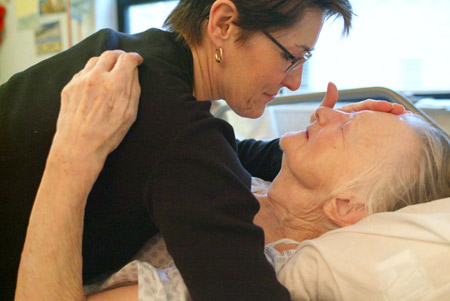What is a Chrysalis Room?
A Chrysalis Room is a private, spacious, tranquil room in a long-term care community or a hospital, which feels just like home. Within that supportive environment, a dying person is treated with devotion and kindness, surrounded by those they love. This gathering place creates a sacred space for the final stage of transformation.
How the Chrysalis Room Came To Be – A Story

By 2000 when my mother moved to a long-term care community or LTC, I had spent six years as a volunteer on a 17-bed AIDS ward in a Chicago hospital. There was no cure for the disease and all of our patients received love and kindness along with compassionate medical care. It was a special place, a hospice unit by another name.
Some died alone in the ICU. Some died quietly on our unit. Others went into hospice and died gently at home with loved ones. Witnessing the difference in dying experiences moved me to become a hospice volunteer.
I had retired and become single the year before mom moved to LTC. I found myself with her five days a week. At the time, I was also visiting hospice patients in their homes and at other nursing homes. Death interested me.
Mother’s LTC community housed 160 residents, mostly very old or very sick. All were dying sooner or later, almost two a month. Most were sent to the hospital to die. I was able to convince some families to admit loved ones to hospice care and had the privilege to serve as their volunteer. The more I witnessed death the more I realized how little anyone knew about dying.
At The Chrysalis Room: Transforming the End of Life Experience” presented by Loretta Downs and Dawn Mondschein, Administrator (now Executive Director), Central Baptist Village, Norridge, IL., at the Pioneer Network National Conference in 2015. See their Chrysalis Room here: cbvillage.org/lifestyle-options/the-chrysalis-room/
Families were unprepared. Few residents had any advance directives beyond a DNR (Do Not Resuscitate order). And because the staff feared death, they wanted residents to die in the hospital. For the few who entered hospice care, keeping vigil in crowded shared rooms with barely place for one family member to sit comfortably at the bedside was the norm.
When a resident died no one talked about it for fear of a HIPAA violation or frightening the other residents. Their room was emptied immediately and they disappeared from the community they called home as if they never lived there.
I knew we had to do better. We had to create a sacred space where staff and loved ones could treat the dying with love and kindness, and keep vigil with them so they didn’t die alone. I called it the Chrysalis Room.
I proposed the idea at mother’s LTC community in December, 2005, and she died in the first Chrysalis Room on April 10, 2006. Every year since, more residents have benefitted. The Chrysalis Room in her LTC community set in motion a huge cultural shift:
- More residents were admitted to hospice care.
- More died “at home” as they had hoped and not in a hospital.
- Staff competence with care of the dying increased.
- Other residents participated in the vigil process and became less fearful of their own deaths.
- The organization began to educate staff about advance care planning, giving residents control of their medical treatment at end of life. Feeding tube use declined.
- Families reported higher levels of satisfaction with the care given loved ones.
Mother’s death was a supported, peaceful, natural death surrounded by loved ones and cared for with dignity and respect both before and after death. It was a spiritual process unfolding in sacred space, in the place she called home. Hers was, by all definitions, a very good death.
In a culture saturated with violence it’s rare for us to glimpse a gentle, natural death. I have gladly shared these images of my mother’s last days of life and the hours after her death with thousands of people at conferences and meetings. It has inspired culture change.
Learn more about the Chrysalis Room:
- Mather LifeWays Institute of Aging Award (PDF)
- Chrysalis Rooms Lend Families Support
- View the transcript of Loretta’s appearance at Death Expo 2016 (PDF) »
I have compiled a brief slide show of photos taken in the last eight days of my mother’s life and the hours after her death, in the first Chrysalis Room. It begins on her 93rd birthday. You see her after the stroke she suffered ten days before her death—ten days after she told me she “was taking a trip on a cloud.” Pay attention to how visitors and staff treat and support her. When you see her on a blue butterfly pillow, she has died. Her hospice aide arrived, not knowing mother has died, and she cares for her body as though my mother were a queen.
Please join me in keeping vigil with Anna in the Chrysalis Room.
